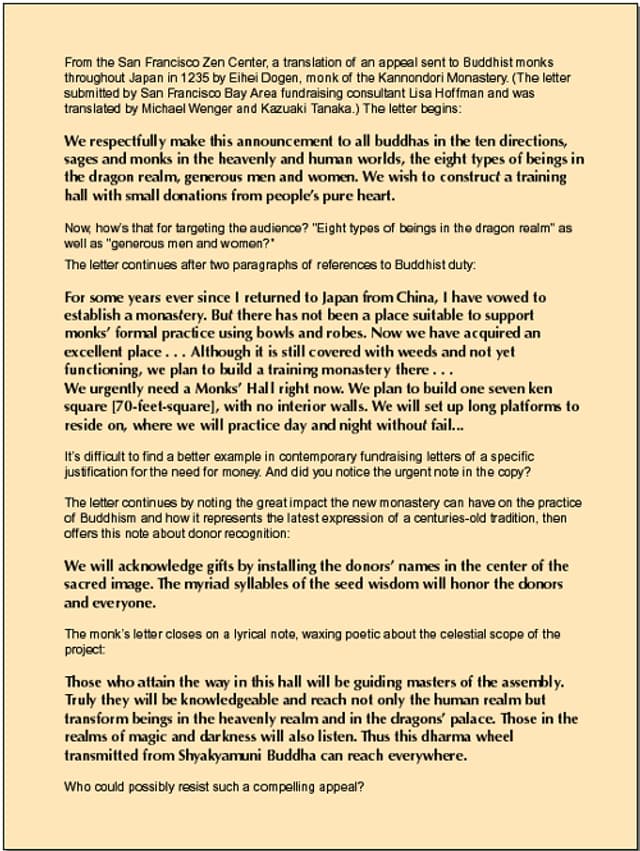Eihei Dogen: fundraising letter from 1235
- Exhibited by
- SOFII
- Added
- October 28, 2018
- Medium of Communication
- Direct mail
- Target Audience
- Individuals
- Type of Charity
- Religious, faith-based
- Country of Origin
- Japan
- Date of first appearance
- 1235
SOFII’s view
This letter, sent in the year 1235, may be the oldest fundraising letter on record. It’s certainly the oldest we know of. It is also an extraordinarily competent appeal. The letter identifies the different types of people that the writer wishes to address. It doesn’t just describe the need that donors can meet, it also recognises the benefits that donors might receive when they respond.
Contributed to SOFII by
Mal Warwick
Objective
Eihei Dogen, a Buddhist sage, wrote this letter to raise funds so that a training centre for monks in Japan could be built.
Background
Explanatory extract from The Soto Approach to Zen, pages 203-204, ‘The place of Dogen’, by Professor Masunaga (1958).
Eihei Dogen is the greatest religious figure and creative thinker in Japanese history. Thoughtful leaders outside the Soto sect have declared that the essence of Japanese culture cannot be correctly understood without considering this great Zen master. Deeply impressed at the thoroughness and depth of Dogen's thought, many Japanese have gained new confidence in the potentialities of their culture.
Dogen enjoys such high regard because his Philosophy, religion, and Personality blend with the ideals held by humanity throughout history. His ideas are universally applicable. Dogen's greatness rests on three Points: his profundity his practicality, and his nobility. His principal work, Shobogenzo, in 95 chapters, is a true masterpiece; it clearly reveals his thought and faith. Instead of writing in classical Chinese, so popular in those days, Dogen used Japanese so that every one will be able to read it. His style is concise and to the point. His thought is noble and profound. His sharp logic and deep insight not only put him at the forefront of Japanese thought, but also give him an important Place in modern philosophy. Because of these features the standpoint of Dogen provide a base for synthesizing Oriental and Occidental thought.
Dogen freed himself from the illusion of the ego, the result of dualistic thinking and he experienced deeply the bliss of Buddhist truth. He continued his religious training in China for two years before returning to Japan at the age of 28.
Dogen's greatest desire was to spread the Buddhist religion and thereby benefit all mankind. He first settled in Kosho Temple where he trained Zen monks. He had a Zen training hall (Dojo) built and lectured before both the Buddhist clergy and laity for more than 10 years. In 1243, at the urging of Hatano Yoshishige, he moved to Echizen, now Fukui Prefecture, and founded the Eihei Temple, which today is one of the two head temples of the Soto sect. Burning with enthusiasm to teach true Buddhism to all seekers, he spent some 10 years there leading a quiet, religious life.
But Dogen's significance is not found merely in the excellence of his theories. We should always remember that Dogen never amuses himself with empty words and barren phrases divorced from reality. In Dogen's writings we find theory and practice, knowledge and action, inseparably entwined. The detailed Zen regulations found in Dogen's Eihei Daishingi established this fact very clearly.
Special characteristics
This may be the oldest direct mail fundraising letter in existence. If you know of one that’s older, please let us know in the comments section below.
Influence / impact
The letter was lost for years and is largely unknown to fundraisers. However it clearly shows use of sophisticated targeting and donor profiling, the offer of an incentive for donors, and very clear development of the proposition.
Merits
Assuming it is authentic, this letter is a priceless exhibit for SOFII.
Note on the provenance of this letter and also the anti-slavery letter, from Mal Warwick:
‘Friends and colleagues competed to pass along to me the world’s first example of a direct mail fundraising letter. I thought I’d hit the jackpot when writer Adam Hochschild presented me with a photocopy from the Minute Books of the Society for Effecting the Abolition of the Slave Trade, minutes of the meeting of October 7, 1788.
‘Imagine my surprise, then, to receive a much older but far more contemporary-sounding direct mail appeal from San Francisco Bay Area fundraising consultant Lisa Hoffman. Lisa works with the San Francisco Zen Center, and there she encountered a translation of an appeal sent to Buddhist monks throughout Japan in 1235 by Eihei Dogen, monk of the Kannondori Monastery (The letter was translated by Michael Wenger and Kazuaki Tanaka).’
Can anyone find an even older example than Mal’s?
 View original image
View original image


















